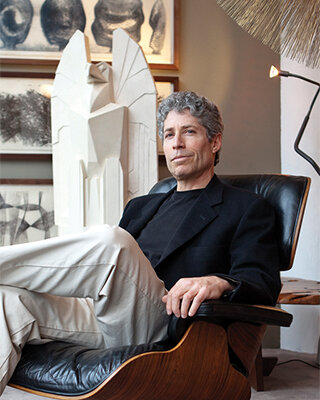183
183
USA, c. 1970
slate, walnut 15½ h × 60 w × 22 d in (39 × 152 × 56 cm)
slate, walnut 15½ h × 60 w × 22 d in (39 × 152 × 56 cm)
estimate: $5,000–7,000
result: $4,000
follow artist

Jim Elkind, founder Lost City Arts—of one of the most influential design galleries in New York City—has design in his DNA. Elkind grew up in a modernist house full of mid-century modern furniture and spent many weekends traveling into New York with his mother, visiting museums and exploring the city. He fondly recalls her pointing up at the skyscrapers and their architectural details, encouraging and instilling in him a curiosity about his surroundings and an attention to detail that would go on to shape his future career.
The idea to open a gallery originally came to Elkind during a visit to the annual juried art show at University of Wisconsin, Madison, where he attended college. The vetted show featured several hundred artists, many of whom, he realized, were extremely talented but would never make it into the mainstream art world. Taking a page from his entrepreneur father’s book, Elkind imagined opening a gallery in New York called the Gallery of the Unknown Artist where he would feature work by up-and-coming artists from universities around the country.
Phillip Lloyd Powell 1919–2008
Celebrated American furniture maker and designer Phillip Lloyd Powell was born in Germantown, Pennsylvania in 1919. Powell is best known for his innovative and hands-on approach to the production of studio furniture that disregarded industrial mass production methods in favor of creating limited runs of meticulously detailed, hand-carved pieces.
A self-taught natural at the craft of woodworking, Phillip Lloyd Powell began creating custom furniture for friends and family as a teenager. Looking to further develop his craft, he enrolled at Drexel Institute of Technology (now Drexel University) in 1939 to study mechanical engineering. His academic career was cut short in 1940 when he was drafted into the Army Air Corps. During his service as a meteorologist, stationed in Great Britain, Powell dreamed of returning home and settling in the quiet, river town of New Hope; his dream came to fruition in 1947 when he purchased an acre of land in the Bucks County artists’ community. Powell built his own home and earned a living selling works by noted mid-century designers such as Herman Miller and Isamu Noguchi.
At the urging of his friend George Nakashima, already an established studio furniture maker, Powell began designing his own furniture. He established a showroom in the heart of New Hope in 1953, open only by appointment and on Saturday evenings. In 1955, he began sharing his studio with Paul Evans. The two artists shared a creative space until 1966, growing their businesses and collaborating on select furniture designs. In addition to his detailed woodworking, Powell also created pieces in stone, metal and slate.
Though Powell began his work in the middle of the 20th century, his designs stand apart from the archetypal clean, sharp lines of many other mid-century makers. Along with his fellow Delaware Valley Modernists, George Nakashima and Wharton Esherick, he sought to elevate the natural form of wood and preferred organic curves and materials. A classic example of this is the singular, sculpted fireplace now on permanent exhibition, along with several other important pieces, at the Michener Museum of Art in Doylestown, Pennsylvania. But Powell’s work was also inspired by his love of world travel; The Powell Door, an intricately carved and brightly painted pine door (also at the Michener Museum of Art) suggests the influence of India, Spain, Portugal, Sicily, and Morocco.
Owing to the intricacies of his designs and his preference to work alone, Powell is estimated to have produced less than 1,000 pieces before his death in 2008.
Upcoming Lots Phillip Lloyd Powell
Auction Results Phillip Lloyd Powell
Auction Results Paul Evans and Phillip Lloyd Powell